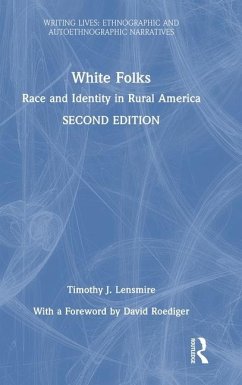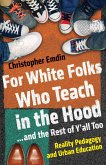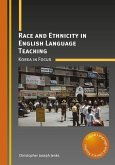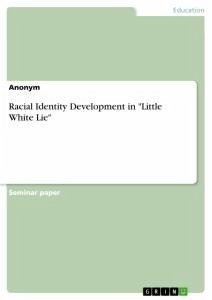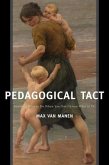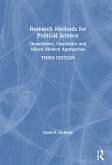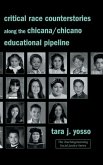This second edition of White Folks features a new preface-by renowned critical whiteness studies scholar David Roediger-that places the book in historical and political context. It also includes an expanded discussion by Lensmire on doing research on race with white people.
Hinweis: Dieser Artikel kann nur an eine deutsche Lieferadresse ausgeliefert werden.
Hinweis: Dieser Artikel kann nur an eine deutsche Lieferadresse ausgeliefert werden.
Intelligent, ambivalent, and penetrating, Lensmire is sincerely vulnerable as he struggles to make sense of the complex ways his hometown peers and he used people of color to define themselves, why the rest of white America has for generations, and why they may for generations to come. Lensmire has the wisdom to put many things in their right place critically and creatively while astutely realizing many mysteries remain.
Jim Garrison, Virginia Tech and Uppsala University
White Folks is theoretically robust and empirically grounded. This grand piece of scholarship is an act of love; its beautiful rendering is a work of art.
The late Garrett Albert Duncan
Slim, hard-hitting, and animated by a cast of fascinating characters, White Folks offers a strong sense of where the study of whiteness has been and of where it might need to go.
From the Foreword by David Roediger, University of Kansas
In these tense moments of resurgence of white identity politics, Tim Lensmire's intrepid yet compassionate ethnographic exploration lifts the veil on White Folks to reveal complexities, conflicts, and contradictions at the core of white racialized selves, evidenced by grounded insights from their own experiences. This cogently written book uniquely captures how whiteness and blackness have always been intricately linked in spite of and because of the violent history and hierarchy of race as it is socially constructed in the United States.
Jabari Mahiri, Professor of Education, UC Berkeley, Brinton Family Chair in Urban Teaching
Lensmire's stories of his own and white community members' memories of racism, told in conversation with essays by Ellison, Baldwin, Thandeka, and Hall, offer essential insights into the contradictory and continuing formation of white racial identities.
Educators, committed to dismantling racial inequality, will find these stories and related analyses to be compelling openings to dialogue and reflection -- about the ways racism, whether openly expressed or swiftly silenced, shapes the talk, emotions, interactions, expectations, daily human dramas, and imagined futures of white folks in rural America. Lensmire's clear-sighted storytelling calls us to see the distorted relationships we have made with/in ourselves, to name the unending costs of racism and to change the ways we read, write, and talk about whiteness and racial inequality in school and society.
Patricia Enciso, Professor of Literature, Literacy, and Equity Studies, The Ohio State University
Lensmire's prose is strong and empathic, telling stories that are both simple and incredibly complex. His methods are (auto)ethnographic, and his subject is public pedagogy-the ways public space, popular culture, and everyday practices teach us what we should know, who we should be, and what we should value. . . . At this moment, I can think of no more important text for teachers and teachers-to-be to read and discuss than Lensmire's short, carefully theorized book.
Patrick Shannon, Pennsylvania State University, in Journal of Research in Rural Education
White Folks may be viewed as an attempt to respond to this call [for more complex treatments of how to work with white people on questions of race and white supremacy], weaving together two strategies. The first is theoretical. From the broad body of academic and belletristic work on whiteness, Lensmire pulls out and wrestles with those insights he believes to be most useful for moving forward. . . . The second-and more distinctive-strategy is personal: Lensmire decides to go home.
Daniel Oppenheimer in The Point Magazine
One of the most important contributions that Lensmire makes to the field of race and ethnicity is unmasking the interiority of whiteness - as a physical place and a psychic location. From the first chapter, Lensmire challenges the myth-making of the affectionate Heartland by recalling how the region is born from indigenous genocide. Disneyfied stories of rural America cannot white out the dark history that continues to haunt the soul of a nation. The un/masking that Lensmire performs throughout the book to explore the interiority of whiteness is incredibly affective. The racial epiphanies recall guilt, shame, anxiety, desire and fear, and those feelings inform an ontological whiteness that Lensmire suggests emerges from profound racial ambivalence - an ambivalence that readers recognize from the spectacular minstrel performances to the everyday enactment of white identity.
Aisha Durham, University of South Florida, in Ethnic & Racial Studies
Jim Garrison, Virginia Tech and Uppsala University
White Folks is theoretically robust and empirically grounded. This grand piece of scholarship is an act of love; its beautiful rendering is a work of art.
The late Garrett Albert Duncan
Slim, hard-hitting, and animated by a cast of fascinating characters, White Folks offers a strong sense of where the study of whiteness has been and of where it might need to go.
From the Foreword by David Roediger, University of Kansas
In these tense moments of resurgence of white identity politics, Tim Lensmire's intrepid yet compassionate ethnographic exploration lifts the veil on White Folks to reveal complexities, conflicts, and contradictions at the core of white racialized selves, evidenced by grounded insights from their own experiences. This cogently written book uniquely captures how whiteness and blackness have always been intricately linked in spite of and because of the violent history and hierarchy of race as it is socially constructed in the United States.
Jabari Mahiri, Professor of Education, UC Berkeley, Brinton Family Chair in Urban Teaching
Lensmire's stories of his own and white community members' memories of racism, told in conversation with essays by Ellison, Baldwin, Thandeka, and Hall, offer essential insights into the contradictory and continuing formation of white racial identities.
Educators, committed to dismantling racial inequality, will find these stories and related analyses to be compelling openings to dialogue and reflection -- about the ways racism, whether openly expressed or swiftly silenced, shapes the talk, emotions, interactions, expectations, daily human dramas, and imagined futures of white folks in rural America. Lensmire's clear-sighted storytelling calls us to see the distorted relationships we have made with/in ourselves, to name the unending costs of racism and to change the ways we read, write, and talk about whiteness and racial inequality in school and society.
Patricia Enciso, Professor of Literature, Literacy, and Equity Studies, The Ohio State University
Lensmire's prose is strong and empathic, telling stories that are both simple and incredibly complex. His methods are (auto)ethnographic, and his subject is public pedagogy-the ways public space, popular culture, and everyday practices teach us what we should know, who we should be, and what we should value. . . . At this moment, I can think of no more important text for teachers and teachers-to-be to read and discuss than Lensmire's short, carefully theorized book.
Patrick Shannon, Pennsylvania State University, in Journal of Research in Rural Education
White Folks may be viewed as an attempt to respond to this call [for more complex treatments of how to work with white people on questions of race and white supremacy], weaving together two strategies. The first is theoretical. From the broad body of academic and belletristic work on whiteness, Lensmire pulls out and wrestles with those insights he believes to be most useful for moving forward. . . . The second-and more distinctive-strategy is personal: Lensmire decides to go home.
Daniel Oppenheimer in The Point Magazine
One of the most important contributions that Lensmire makes to the field of race and ethnicity is unmasking the interiority of whiteness - as a physical place and a psychic location. From the first chapter, Lensmire challenges the myth-making of the affectionate Heartland by recalling how the region is born from indigenous genocide. Disneyfied stories of rural America cannot white out the dark history that continues to haunt the soul of a nation. The un/masking that Lensmire performs throughout the book to explore the interiority of whiteness is incredibly affective. The racial epiphanies recall guilt, shame, anxiety, desire and fear, and those feelings inform an ontological whiteness that Lensmire suggests emerges from profound racial ambivalence - an ambivalence that readers recognize from the spectacular minstrel performances to the everyday enactment of white identity.
Aisha Durham, University of South Florida, in Ethnic & Racial Studies

